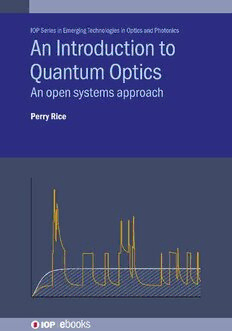Table Of ContentAn Introduction to Quantum
Optics
An open systems approach
IOP Series in Emerging Technologies in Optics and Photonics
Series Editor
R Barry Johnson a Senior Research Professor at Alabama A&M
University, has been involved for over 50 years in lens design,
optical systems design, electro-optical systems engineering, and
photonics. He has been a faculty member at three academic
institutions engaged in optics education and research, employed
by a number of companies, and provided consulting services.
DrJohnsonisanIOPFellow,SPIEFellowandLifeMember,OSAFellow,andwas
the 1987 President of SPIE. He serves on the editorial board of Infrared Physics &
Technology and Advances in Optical Technologies. Dr Johnson has been awarded
manypatents,haspublishednumerouspapersandseveralbooksandbookchapters,
andwasawardedthe2012OSA/SPIEJosephWGoodmanBookWritingAwardfor
LensDesignFundamentals,SecondEdition.Heisaperennialco-chairoftheannual
SPIE Current Developments in Lens Design and Optical Engineering Conference.
Foreword
Untilthe1960s,thefieldofopticswasprimarilyconcentratedintheclassicalareasof
photography, cameras, binoculars, telescopes, spectrometers, colorimeters, radio-
meters,etc.Inthelate1960s,opticsbegantoblossomwiththeadventofnewtypesof
infrareddetectors,liquidcrystaldisplays(LCD),lightemittingdiodes(LED),charge
coupled devices (CCD), lasers, holography, fiber optics, new optical materials,
advances in optical and mechanical fabrication, new optical design programs, and
many more technologies.With thedevelopment ofthe LED,LCD, CCD and other
electo-optical devices, the term ‘photonics’ came into vogue in the 1980s to describe
thescienceofusinglightindevelopmentofnewtechnologiesandtheperformanceof
amyriadofapplications.Today,opticsandphotonicsaretrulypervasivethroughout
societyandnewtechnologiesarecontinuingtoemerge.Theobjectiveofthisseriesis
to provide students, researchers, and those who enjoy self-teaching with a wide-
ranging collection of books that each focus on a relevant topic in technologies and
applicationofopticsand photonics.Thesebookswill provideknowledgetoprepare
thereadertobebetterabletoparticipateintheseexcitingareasnowandinthefuture.
The title of this series is Emerging Technologies in Optics and Photonics where
‘emerging’ is taken to mean ‘coming into existence,’ ‘coming into maturity,’ and
‘coming into prominence.’ IOP Publishing and I hope that you find this Series of
significant value to you and your career.
An Introduction to Quantum
Optics
An open systems approach
Perry Rice
Autonomy, Artificial Intelligence, and Machine Learning Lab, Azimuth Corporation,
2970 Presidential Dr., Suite 200 Fairborn, OH 45324, USA
IOP Publishing, Bristol, UK
ªIOPPublishingLtd2020
Allrightsreserved.Nopartofthispublicationmaybereproduced,storedinaretrievalsystem
ortransmittedinanyformorbyanymeans,electronic,mechanical,photocopying,recording
orotherwise,withoutthepriorpermissionofthepublisher,orasexpresslypermittedbylawor
undertermsagreedwiththeappropriaterightsorganization.Multiplecopyingispermittedin
accordancewiththetermsoflicencesissuedbytheCopyrightLicensingAgency,theCopyright
ClearanceCentreandotherreproductionrightsorganizations.
PermissiontomakeuseofIOPPublishingcontentotherthanassetoutabovemaybesought
atpermissions@ioppublishing.org.
PerryRicehasassertedhisrighttobeidentifiedastheauthorofthisworkinaccordancewith
sections77and78oftheCopyright,DesignsandPatentsAct1988.
ISBN 978-0-7503-1713-9(ebook)
ISBN 978-0-7503-1711-5(print)
ISBN 978-0-7503-1809-9(myPrint)
ISBN 978-0-7503-1712-2(mobi)
DOI 10.1088/978-0-7503-1713-9
Version:20200901
IOPebooks
BritishLibraryCataloguing-in-PublicationData:Acataloguerecordforthisbookisavailable
fromtheBritishLibrary.
PublishedbyIOPPublishing,whollyownedbyTheInstituteofPhysics,London
IOPPublishing,TempleCircus,TempleWay,Bristol,BS16HG,UK
USOffice:IOPPublishing,Inc.,190NorthIndependenceMallWest,Suite601,Philadelphia,
PA19106,USA
This book is dedicated to the memory of my dad, Paul Richard Rice.
A kind and loving man with a great fondness for music.
Contents
Preface x
Acknowledgments xi
Author biography xii
1 Introduction 1-1
1.1 What is quantum optics 1-1
1.2 Open quantum systems 1-4
1.3 This book 1-4
References 1-5
2 Classical electromagnetism and linear optics 2-1
2.1 Maxwell equations and electromagnetic waves 2-1
2.2 Wave equation for fields in a medium 2-5
2.3 Slowly varying envelope approximation 2-9
2.4 Lorentz oscillator model of the atom 2-10
References 2-14
3 QM review 3-1
3.1 Wave mechanics 3-1
3.2 Dirac notation 3-4
3.3 Representations and pictures 3-6
3.4 Pictures 3-10
3.5 Density matrix 3-14
3.6 Choice of basis and measurement 3-15
3.7 Executive summary 3-16
3.8 Entanglement 3-17
References 3-19
4 Two-level dynamics 4-1
4.1 Two-level atoms 4-1
4.2 Atom–field interaction in the electric dipole approximation 4-4
4.3 Introduction to dressed states 4-12
4.4 Perturbation theory and rate equations 4-14
vii
AnIntroductiontoQuantumOptics
4.5 Pauli operators and the Bloch sphere representation 4-17
4.6 Relation to the classical Lorentz model 4-27
4.7 An interlude in the form of the atom–field interaction 4-28
References 4-29
5 Quantum fields 5-1
5.1 Maxwell equations again 5-1
5.2 Quantization of the electromagnetic field 5-1
5.3 Single mode quantized fields 5-5
5.4 Number states 5-8
5.5 Coherent states 5-12
5.6 Squeezed states 5-20
5.7 Cat states 5-29
5.8 Thermal states 5-31
5.9 Vacuum fluctuations and beam splitters 5-32
5.10 Casimir effect 5-37
References 5-37
6 Two-level atom coupled to a quantized field 6-1
6.1 Atom–field interaction in quantum optics 6-1
6.2 Wigner–Weisskopf approximation 6-6
6.3 Cavity modified spontaneous emission 6-8
6.4 Dressed states reprise 6-8
6.5 Heisenberg equations of motion 6-11
6.6 Collapse and revivals of population inversion 6-12
6.7 Vacuum fluctuations and radiation reaction 6-16
References 6-20
7 Coherence and detection 7-1
7.1 Detection of a noiseless classical signal 7-2
7.2 Complex analytic signal 7-5
7.3 Semiclassical photodetection theory 7-7
7.4 Quantum detection theory 7-10
7.5 Optical spectra and first-order coherence 7-12
7.6 Photon statistics and second-order coherence 7-16
7.7 Balanced homodyne detection and the spectrum of squeezing 7-21
viii
AnIntroductiontoQuantumOptics
7.8 Wave–particle duality and conditioned homodyne detection 7-23
7.9 Cross-correlation functions 7-25
References 7-26
8 The density matrix and the master equation or wave 8-1
functions: the big lie
8.1 Open quantum systems 8-1
8.2 Density matrix and reduced density matrix 8-2
8.3 The master equation with dissipation 8-7
8.4 Quantum regression theorem 8-11
8.5 Derivation of the master equation in the Born–Markoff 8-13
approximation
8.6 Other types of reservoirs 8-18
8.7 Alternative derivation of Lindblad equation 8-19
References 8-24
9 Quantum trajectory theory 9-1
9.1 Some examples 9-7
9.2 And now for a little formality 9-14
9.3 Homodyne detection and quantum state diffusion 9-18
9.4 Two-time averages 9-21
9.5 Some final thoughts on trajectories 9-22
References 9-22
10 Quasiprobability distributions 10-1
10.1 Glauber–Sudarshan P representation 10-1
10.2 Wigner distribution 10-5
10.3 Husimi Q function 10-10
10.4 Fokker–Planck equations 10-15
10.5 Fermions 10-18
10.6 Langevin equations 10-22
References 10-25
ix

